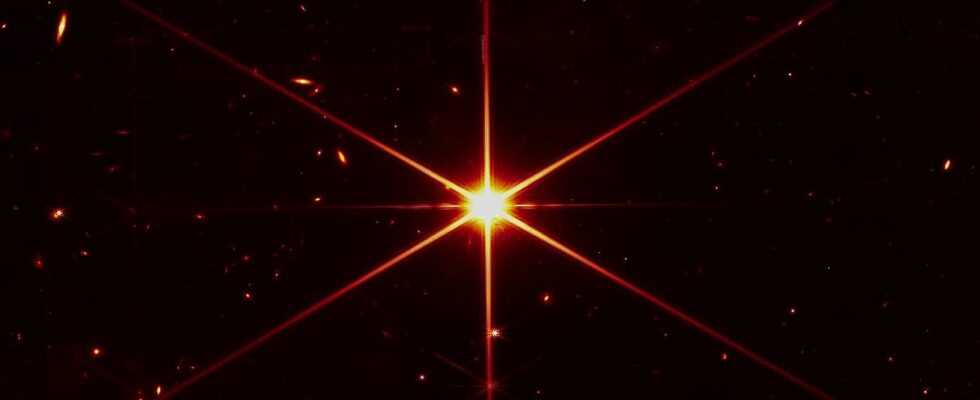4
The JWST space telescope has almost completed the phase of aligning the segments of its primary mirror aimed at acquiring unprecedented images of the universe. After several additional adjustments, the observatory will finally be able to fulfill its mission.
James-Webb main mirror segment alignment evaluation image. © NASA – STScI
The James-Webb telescope, placed for several weeks at the Lagrange L2 point, has just successfully concluded a new calibration stage which brings it closer to its final use. Indeed, its primary mirror, divided into 18 segments, is almost perfectly positioned to scan the cosmos in high definition in infrared and near infrared radiation. The first “real” results should be unveiled by NASA during the summer of 2022. Meanwhile, on Friday March 11, the JWST was able to capture a photo of the star 2MASS J17554042+6551277 which was used to carry out point.
The bright spots around are none other than galaxies and other stars in the background. Attention, whether with Hubble or James-Webb, the capture of images – and related scientific data – does not work quite like a conventional camera, because the adjustment of the whole is made extremely complex by the 1 .5 million kilometers that separate us from the craft.
⚫️ These dots confirm that Webb’s Near-Infrared Camera, or NIRCam, can collect light from celestial objects — and that starlight from the same star can be reflected from each of Webb’s 18 unaligned mirror segments back at Webb’s secondary mirror and then into NIRCam’s detectors. pic.twitter.com/SYeAO1UlzP
—NASA Webb Telescope (@NASAWebb) February 11, 2022
The entire calibration process was divided into seven steps, NASA scientists explain. Of course, each of these operations is crucial, but they are also intended to be flexible or repeated.
1. Identification of segments
Each of the 18 segments sends back its own image of the targeted star in disorder. A kind of constellation is then visible on the received image. By moving the segments one by one, it is possible to identify them.
To capture this image, more than 1560 captures were made by adjusting the position of the telescope for a total of more than 2 billion pixels. © Nasa
2. Segment alignment
Once identified, they are aligned by correcting the most important errors. The captured image then suggests a hexagon. A debugging phase then takes place and a more precise calculation of the errors is carried out.
With the first alignment of the segments, the 18 captures take the form of a hexagon which requires a first focus. © Nasa
3. Beam convergence
In order to assemble the different iterations received, all the light received must converge in a single point. The segments divided into three groups see their position modified successively to create a “single image”.
This simulation shows the convergence step by step thanks to the adjustment of the segments of the main mirror. © Nasa
4. Primary Adjustment
Although deemed “rude” (coarse in English) by the scientists, the new adjustment phase only operates on a few tens of micrometers. The placement of the segments is changed vertically, and rather than “behave like 18 small separate telescopes”the segments should be one after this step.
5. Precise fit
This sequence makes it possible to calculate and correct the errors to dispose ultimately in perfect focus. It also uses the method used in the segment alignment step. On the other hand, new specific instruments are used to better individually adjust the position of the different segments. It was precisely at the end of this phase that we were able to discover the first “clear” image of James-Webb.
⚫️ In the coming weeks, our team will align & focus each of these 18 dots, then stack the dots on top of each other to form a single point — one unified image from all of Webb’s 18 mirror segments. What’s ahead: https://t.co/asidf7mdKBpic.twitter.com/pPZQG13IkO
—NASA Webb Telescope (@NASAWebb) February 11, 2022
6. Aligning the telescope according to the field of view
Now that the segments are properly adjusted, it is a question of checking their correct operation with all the on-board instruments and in all possible configurations. Several captures are thus made with different parameters and sensors. If errors are detected, further adjustments are made.
7. Repeat alignment for final corrections
After applying the new corrections obtained in the previous step, the last adjustment phase consists of making a few final corrections on the primary segments. Procedures for fine-tuning are reused. A quality control phase is also performed with each scientific instrument.
An extraordinary project
The launch of the James-Webb space observatory took place on December 25, 2021 and its deployment in early January 2022, following a development phase of more than three decades and many delays. Extraordinary, the telescope weighs more than 6.2 t and has a wingspan of 22 m with its thermal protection shield.
As often, the mission was able to be carried out thanks to international collaborative work between the American NASA, the European ESA and the Canadian CSA. In a few months, James-Webb will be fully operational and will begin the real observation of the distant universe (thus past), galaxies, exoplanets, nebulae, etc.

